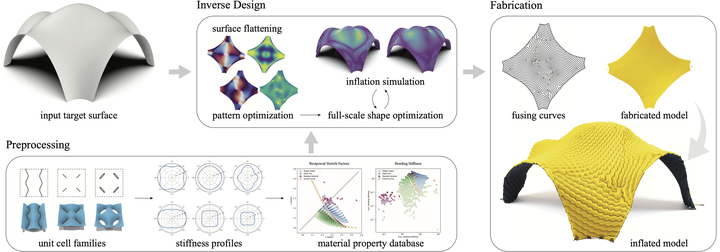Computational Homogenization for Inverse Design of Surface-based Inflatables

Abstract
Surface-based inflatables are composed of two thin layers of nearly inextensible sheet material joined together along carefully selected fusing curves. During inflation, pressure forces separate the two sheets to maximize the enclosed volume. The fusing curves restrict this expansion, leading to a spatially varying in-plane contraction and hence metric frustration. The inflated structure settles into a 3D equilibrium that balances pressure forces with the internal elastic forces of the sheets.
We present a computational framework for analyzing and designing surface-based inflatable structures with arbitrary fusing patterns. Our approach employs numerical homogenization to characterize the behavior of parametric families of periodic inflatable patch geometries, which can then be combined to tessellate the sheet with smoothly varying patterns. We propose a novel parametrization of the underlying deformation space that allows accurate, efficient, and systematical analysis of the stretching and bending behavior of inflated patches with potentially open boundaries.
We apply our homogenization algorithm to create a database of geometrically diverse fusing patterns spanning a wide range of material properties and deformation characteristics. This database is employed in an inverse design algorithm that solves for fusing curves to best approximate a given input target surface. Local patches are selected and blended to form a global network of curves based on a geometric flattening algorithm. These fusing curves are then further optimized to minimize the distance of the deployed structure to target surface.